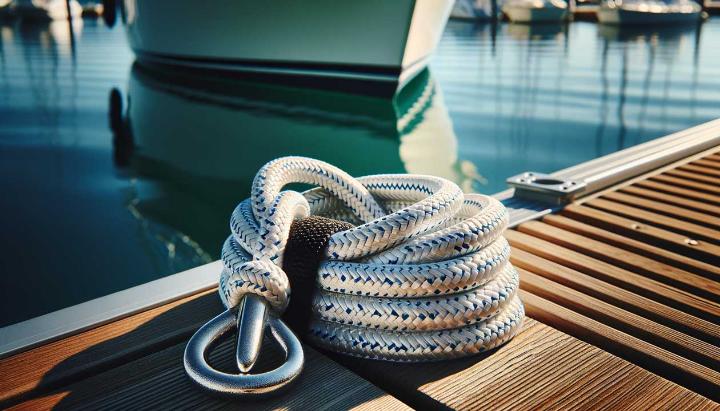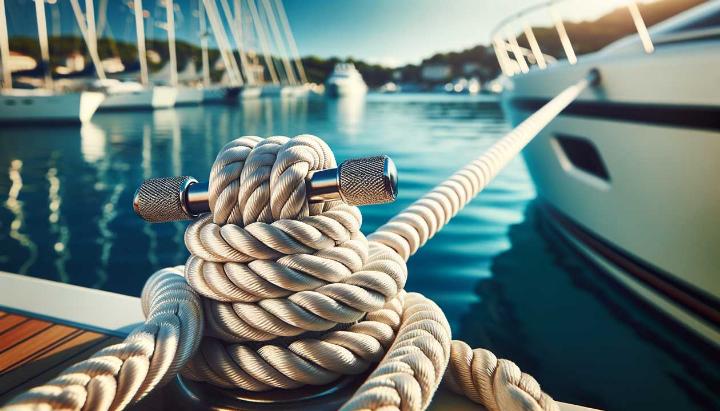Have you ever watched in horror as your prized vessel drifted dangerously close to the dock, held back by nothing more than a fraying rope? If so, you're not alone. The choice of mooring line can make or break your boating experience - quite literally. Today, we're diving into the world of essential boat mooring lines, with a special focus on the unsung heroes of maritime safety: nylon ropes with eye splices and protectors.
As experts in rope manufacturing, we at iRopes have seen firsthand how the right mooring line can transform a boat owner's peace of mind. Nylon isn't just another material; it's a game-changer in the maritime world. Its unique combination of strength, durability, and shock absorption makes it the go-to choice for savvy sailors worldwide.
But the magic doesn't stop there. We'll explore how mooring line eye splices can boost your line's strength by up to 90%, and why mooring line protectors are not just accessories, but essential safeguards for your vessel. Whether you're a weekend warrior or a seasoned captain, this guide will help you navigate the choppy waters of mooring line selection, ensuring your boat stays exactly where you left it - safe and secure.
Advantages of Nylon Boat Mooring Lines
When it comes to securing your vessel, choosing the right mooring line can make all the difference. As a seasoned boater, I've learned that nylon boat mooring lines are the go-to choice for many marine enthusiasts, and for good reason. Let's dive into why these ropes are making waves in the boating community.
Strength and Durability of Nylon Ropes
Nylon mooring lines are renowned for their impressive strength-to-weight ratio. I remember the first time I switched from a traditional rope to a nylon line – the difference was night and day. These robust ropes can withstand the constant tugging and strain that comes with choppy waters and changing tides.
- Superior tensile strength: Nylon lines typically boast a breaking strength of 8,500 to 9,900 pounds for a 1/2-inch diameter rope, outperforming many alternatives.
- Abrasion resistance: The tough exterior of nylon ropes stands up well to rough dock edges and boat cleats, reducing wear and tear over time.
- Long-lasting performance: With proper care, a quality nylon mooring line can serve you faithfully for several boating seasons.
Elasticity and Shock Absorption Benefits
One of the standout features of nylon mooring lines is their incredible elasticity. This property is crucial when you're mooring in areas with significant wave action or tidal changes. I've seen firsthand how this elasticity can protect both your boat and the dock from sudden jerks and impacts.
Did You Know?
Nylon ropes can stretch up to 30% of their length under load, providing excellent shock absorption.
This stretching ability acts like a built-in shock absorber, cushioning your boat against sudden movements and reducing stress on cleats and fairleads. It's particularly beneficial during storms or when dealing with wakes from passing vessels.
Comparing Nylon to Other Mooring Line Materials
While nylon is a top contender, it's worth comparing it to other materials to understand its unique advantages:
- Nylon vs. Polyester: Nylon offers superior stretch and shock absorption, while polyester holds its length better when wet.
- Nylon vs. Polypropylene: Nylon sinks in water, providing better performance, while polypropylene floats and can potentially tangle in propellers.
Have you ever experienced the difference between these materials firsthand? I'd love to hear about your experiences in the comments below!
Remember, while nylon has many advantages, it's not without its quirks. It can absorb water, which affects its strength when wet, and it has lower UV resistance compared to some other materials. However, for most boating applications, the benefits of nylon mooring lines far outweigh these minor drawbacks.
Choosing the right mooring line is an investment in your boat's safety and your peace of mind. With its strength, durability, and shock-absorbing properties, a nylon mooring line is often the smart choice for savvy boaters. So next time you're rigging up your vessel, consider giving nylon a try – your boat (and your nerves) will thank you!
Benefits of Mooring Line Eye Splice
As a seasoned sailor, I've learned that the devil is in the details when it comes to boat safety. One crucial detail that often gets overlooked is the mooring line eye splice. Let me tell you, this simple technique can make a world of difference in your mooring setup.
Strength and Durability Advantages
The first time I used a properly spliced mooring line, I was amazed at the difference in performance. Here's why eye splices are a game-changer:
- Superior strength retention: An eye splice retains up to 90% of the rope's original strength, compared to knots which can reduce strength by up to 50%.
- Increased durability: The smooth profile of an eye splice reduces wear and tear, extending the life of your mooring line.
- Resistance to slippage: Unlike knots that can work loose over time, a well-made eye splice maintains its integrity even under heavy loads.

Practical Applications in Boating
The benefits of eye splices extend beyond just strength. Here's how they improve your overall boating experience:
- Easy attachment: Eye splices create a permanent loop that's perfect for quickly securing your boat to cleats or bollards.
- Professional appearance: There's something undeniably seamanlike about a neatly spliced line. It shows attention to detail and craftsmanship.
- Versatility: From mooring to anchoring, eye splices are useful in various boating applications.
Remember, proper technique is crucial when creating an eye splice. If you're new to splicing, consider seeking guidance from an experienced sailor or taking a workshop. It's a skill that will serve you well throughout your boating journey.
Pro tip: Always protect your eye splices with chafe guards when they're in contact with rough surfaces. This extra step will significantly extend the life of your mooring lines.
Have you tried using eye splices on your mooring lines? I'd love to hear about your experiences in the comments below. And if you haven't yet, why not give it a go on your next boating adventure? Trust me, you'll feel the difference!
Importance of Mooring Line Protectors
As a seasoned sailor, I've learned that the devil is in the details when it comes to boat maintenance. One crucial detail that often gets overlooked is the use of mooring line protectors. These unassuming pieces of equipment play a vital role in preserving your mooring lines and ensuring your vessel's safety.
Extended Lifespan and Safety Benefits
I'll never forget the time I neglected to use chafe guards on a long voyage. The constant rubbing against the boat's chocks left my once-pristine mooring lines frayed and weakened. It was a costly lesson, but one that taught me the true value of mooring line protectors.
- Prevent wear and tear: Chafe guards act as a barrier between your mooring lines and abrasive surfaces, significantly reducing wear.
- Extend rope life: By minimizing friction and damage, protectors can double or even triple the lifespan of your mooring lines.
- Enhance safety: Well-protected lines are less likely to fail, providing better stability and security for your vessel.

Did you know that according to a study by the Boat Owners Association, using proper chafe protection can reduce mooring line replacements by up to 70%? That's a significant saving in both time and money!
Types of Chafe Guards and Their Applications
Over the years, I've experimented with various types of mooring line protectors. Each has its own strengths, suited to different situations:
- Leather chafe guards: Durable and flexible, ideal for areas with constant movement.
- Nylon sleeves: Lightweight and easy to install, perfect for temporary protection.
- Polyester covers: Resistant to UV rays and saltwater, great for long-term outdoor use.
- Rubber protectors: Excellent for heavy-duty applications where maximum shock absorption is needed.
When selecting a chafe guard, consider factors like your boat's size, typical mooring conditions, and the type of mooring lines you use. For my 30-foot sailboat, I've found that a combination of leather guards at the chocks and nylon sleeves along the rails provides optimal protection.
Remember: Even the best chafe guards need regular inspection. Make it a habit to check your protectors and lines for signs of wear before each trip.
Have you had any experiences with mooring line protectors? Whether it's a close call averted or a favourite product you swear by, I'd love to hear your stories in the comments below. Let's help each other keep our boats safe and our mooring lines in top condition!
For more on leveraging nylon ropes for your boating needs, you can read this comprehensive guide on the essential tips for choosing the right boat rope. It provides insights into different materials and their respective advantages, ensuring you make an informed decision for your vessel's safety and performance.
Interested in mastering the art of strong spliced eye techniques for durable rope eye solutions? Discover the unparalleled strength and durability in demanding environments by learning advanced splicing techniques that ensure your marine ropes maintain their integrity under heavy loads.
When it comes to choosing a boat mooring line, opting for a nylon variant brings unparalleled durability, UV and saltwater resistance, and an outstanding stretch capability that cushions shocks, making it a wise investment for ideal performance. Adding a mooring line eye splice enhances security and ease of attachment, while mooring line protectors guard against abrasion, extending the rope's lifespan significantly. These key features collectively ensure reliable and long-lasting mooring solutions for your vessel, emphasising the smart choice of nylon rope with eye splices and protectors.
Inquire About Custom Rope Solutions Today
If you're looking to secure your boat with the best mooring line, fill in the form above to get customised solutions tailored to your needs. Our specialists at iRopes are ready to assist you in finding the perfect match for your vessel's requirements.